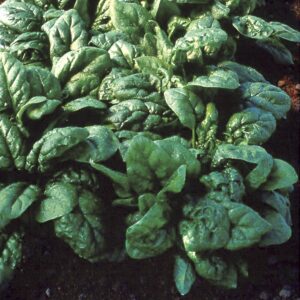Sugarloaf chicory variety of Chicory
Description of Sugarloaf chicory variety of Chicory.
Sugarloaf chicory, also known simply as Sugarloaf, is a variety of chicory known for its compact, cone-shaped heads of tightly packed leaves. Here’s a detailed description:
- Head Shape: Sugarloaf chicory has a distinctive cone-shaped head that resembles a sugarloaf, hence its name. The heads are usually compact and dense.
- Leaf Texture: The leaves of Sugarloaf chicory are typically crisp and tender, with a slightly bitter flavor, characteristic of chicory varieties.
- Colour: The outer leaves of Sugarloaf chicory are usually dark green, while the inner leaves tend to be lighter green or yellowish.
- Size: The size of the heads can vary but they are generally medium-sized, making them suitable for individual servings or culinary use.
- Growth Habit: Sugarloaf chicory grows as a rosette of leaves initially, with the inner leaves tightly packed and forming the characteristic cone shape as they mature.
- Cultural Requirements: Similar to other chicory varieties, Sugarloaf prefers cool weather for optimal growth. It can be grown in both spring and fall seasons, with full sun to partial shade.
- Uses: Sugarloaf chicory is commonly used in salads for its crisp texture and slightly bitter flavour. It can also be cooked by braising or grilling to mellow out its bitterness. Overall, Sugarloaf chicory is valued for its attractive appearance, crisp texture, and unique flavour profile, which adds depth to salads and other culinary dishes.
Planting instructions for Sugarloaf chicory variety of Chicory.
To plant Sugarloaf chicory, follow these steps:
- Choose the Right Location: Select a sunny spot in your garden with well-drained soil. Chicory prefers slightly acidic to neutral soil pH.
- Prepare the Soil:** Loosen the soil to a depth of about 8-10 inches and incorporate organic matter like compost or aged manure to improve fertility and drainage.
- Sow the Seeds: Plant Sugarloaf chicory seeds directly in the garden about ¼ to ½ inch deep, spacing them around 12 inches apart in rows that are 18 to 24 inches apart.
- Watering: Keep the soil consistently moist but not waterlogged, especially during dry periods. Water regularly, aiming to keep the soil evenly moist.
- Thinning: Once the seedlings emerge, thin them to ensure they’re spaced properly, allowing each plant enough room to grow.
- Weeding: Keep the area around the plants weed-free to reduce competition for nutrients and water.
- Fertilizing: Chicory is not heavy feeder, but you can side-dress with a balanced fertilizer once or twice during the growing season.
- Harvesting: Sugarloaf chicory can be harvested when the heads are firm and tightly packed. You can cut the heads at ground level or pull up the entire plant.
- Storage: Store harvested chicory heads in the refrigerator for up to a week, preferably wrapped in damp paper towels or placed in a plastic bag to retain moisture.
- Successive Plantings: For a continuous harvest, consider planting chicory seeds in succession every few weeks.
Description of Sugarloaf chicory variety of Chicory.
Sugarloaf chicory, also known simply as Sugarloaf, is a variety of chicory known for its compact, cone-shaped heads of tightly packed leaves. Here’s a detailed description:
- Head Shape: Sugarloaf chicory has a distinctive cone-shaped head that resembles a sugarloaf, hence its name. The heads are usually compact and dense.
- Leaf Texture: The leaves of Sugarloaf chicory are typically crisp and tender, with a slightly bitter flavor, characteristic of chicory varieties.
- Colour: The outer leaves of Sugarloaf chicory are usually dark green, while the inner leaves tend to be lighter green or yellowish.
- Size: The size of the heads can vary but they are generally medium-sized, making them suitable for individual servings or culinary use.
- Growth Habit: Sugarloaf chicory grows as a rosette of leaves initially, with the inner leaves tightly packed and forming the characteristic cone shape as they mature.
- Cultural Requirements: Similar to other chicory varieties, Sugarloaf prefers cool weather for optimal growth. It can be grown in both spring and fall seasons, with full sun to partial shade.
- Uses: Sugarloaf chicory is commonly used in salads for its crisp texture and slightly bitter flavour. It can also be cooked by braising or grilling to mellow out its bitterness. Overall, Sugarloaf chicory is valued for its attractive appearance, crisp texture, and unique flavour profile, which adds depth to salads and other culinary dishes.
Planting instructions for Sugarloaf chicory variety of Chicory.
To plant Sugarloaf chicory, follow these steps:
- Choose the Right Location: Select a sunny spot in your garden with well-drained soil. Chicory prefers slightly acidic to neutral soil pH.
- Prepare the Soil:** Loosen the soil to a depth of about 8-10 inches and incorporate organic matter like compost or aged manure to improve fertility and drainage.
- Sow the Seeds: Plant Sugarloaf chicory seeds directly in the garden about ¼ to ½ inch deep, spacing them around 12 inches apart in rows that are 18 to 24 inches apart.
- Watering: Keep the soil consistently moist but not waterlogged, especially during dry periods. Water regularly, aiming to keep the soil evenly moist.
- Thinning: Once the seedlings emerge, thin them to ensure they’re spaced properly, allowing each plant enough room to grow.
- Weeding: Keep the area around the plants weed-free to reduce competition for nutrients and water.
- Fertilizing: Chicory is not heavy feeder, but you can side-dress with a balanced fertilizer once or twice during the growing season.
- Harvesting: Sugarloaf chicory can be harvested when the heads are firm and tightly packed. You can cut the heads at ground level or pull up the entire plant.
- Storage: Store harvested chicory heads in the refrigerator for up to a week, preferably wrapped in damp paper towels or placed in a plastic bag to retain moisture.
- Successive Plantings: For a continuous harvest, consider planting chicory seeds in succession every few weeks.





